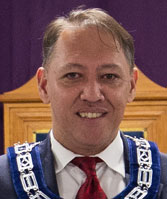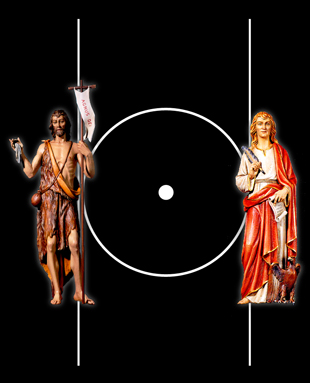Exploring the Holy Saints John at Jerusalem
The symbols of Masonry provide direction on the path to further knowledge.
By: Burx Norrod
Sandoval Lodge No. 76

In the annals of Freemasonry, the mention of a Lodge dedicated to the Holy Saints John conjures a tapestry woven with tradition, symbolism, and an ethos of enlightenment. This venerable institution, with its roots tracing back centuries, stands apart from other fraternal organizations by virtue of its profound ceremonial rites.
At the heart of Freemasonry lies a profound reverence for ritual work. Unlike other charitable fraternities, Freemasonry’s essence is deeply intertwined with the intricacies of its ceremonial practices. Within the Craft, one finds a rich amalgamation of esoteric teachings, a mosaic of wisdom aimed at illuminating the path toward personal improvement and moral enlightenment.
As the sun begins its ascent in the month of June, in the year of our Lodge 6024 A.L., we prepare to commemorate a significant milestone in the history of Freemasonry. It has been 307 years since four lodges in England convened to establish the first ‘Grand Lodge’ on June 24, 1717, thereby heralding the birth of modern Freemasonry. This auspicious date coincides with the feast day of St. John the Baptist, one of the two revered patron saints of Freemasonry, the other being St. John the Evangelist, whose commemoration falls on December 27. Notably, it was on this latter date in 1813 that the United Grand Lodge of England was formed, perpetuating the legacy of unity among brethren.
Yet, this discourse does not seek to dwell solely on the historical genesis of Freemasonry or the veneration of the Saints John. Rather, its focus is on the paramount importance of delving into the depths of Masonic ritual work. It is this profound engagement with our ceremonial heritage that distinguishes Freemasonry from other fraternal orders, such as the Elks, whose outward trappings may bear superficial resemblance, but lack the depth of symbolic significance.
In this era of rapid change and shifting paradigms, the imperative for Masons to delve beyond the mere recitation of ritualistic texts has never been more pronounced. It is insufficient to merely memorize the words of our degree proficiencies; rather, we must strive to imbibe their intrinsic meanings. Too often, one encounters brethren who falter when queried on the significance of the Holy Saints John or the allegorical phrase “at Jerusalem.” This calls for a collective reevaluation and a renewed commitment to understanding the profound symbolism embedded within our rituals.
I issue a challenge to every Brother: revisit the proficiencies, beginning with the Entered Apprentice degree, and embark on a journey of introspection and enlightenment. Let us delve into the nuances of our ceremonial heritage not as a perfunctory exercise but as a quest for genuine comprehension. For within the seemingly simple Q&A sessions lie profound lessons waiting to be unraveled.
 The Holy Saints John, with their multifaceted symbolism, offer a gateway to deeper understanding. St. John the Baptist, characterized by his fervent zeal, stands juxtaposed with St. John the Evangelist, epitomizing knowledge and faith. As Masons, we are called upon to strike a balance between these contrasting virtues, embodying both fervor and enlightenment in our pursuits. Furthermore, the alignment of their feast days with the solstices—St. John the Baptist on the Summer Solstice and St. John the Evangelist on the Winter Solstice—serves as a poignant reminder of nature’s cyclical rhythms and the eternal struggle between light and darkness.
The Holy Saints John, with their multifaceted symbolism, offer a gateway to deeper understanding. St. John the Baptist, characterized by his fervent zeal, stands juxtaposed with St. John the Evangelist, epitomizing knowledge and faith. As Masons, we are called upon to strike a balance between these contrasting virtues, embodying both fervor and enlightenment in our pursuits. Furthermore, the alignment of their feast days with the solstices—St. John the Baptist on the Summer Solstice and St. John the Evangelist on the Winter Solstice—serves as a poignant reminder of nature’s cyclical rhythms and the eternal struggle between light and darkness.
To delve further into our rich history – we’ll find that it was actually St. Stephen who was Freemasonry’s first Patron Saint – as he is the Patron Saint of Masons, and, his Feast Day falls on December 26, just a day before St. John the Evangelist.
And why “at Jerusalem”? This phrase, pregnant with symbolic significance, evokes the sacred precincts of King Solomon’s Temple. Just as every Masonic Lodge serves as a microcosm of this legendary edifice, so too does it beckon us to explore the allegorical riches contained within its hallowed walls.
Indeed, much can be gleaned from the construction of King Solomon’s Temple and the allegories it embodies. But that, dear brethren, is a tale for another time—a narrative waiting to unfold in the sacred precincts of our Masonic discourse.
